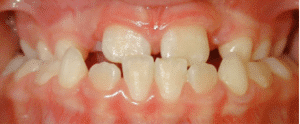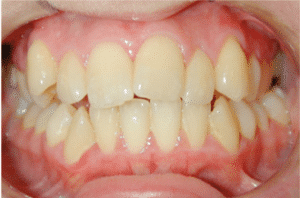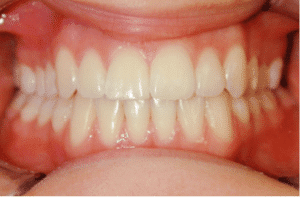Upper Palatal Expander
The Upper Palatal Expander (UPE) is a fixed brace designed to widen the upper jaw. It was first introduced by Angell in 1877. However, he was not taken seriously as the mere possibility of an upper palatal expander was disputed and the procedure was initially forgotten about for decades. It was re-discovered after 1945 as a result of the work of Haas, Timms and Derichsweiler and its indisputable place in orthodontics is now assured. The appliance is usually fixed with tapes to the 1. molars and the 1. premolars and, as of very recently, also fixed on plastic tracks around all the posterior teeth.
The very rigid appliance is held in place by a jack screw in the middle, which, over a period of 2-8 weeks makes it possible for the two halves of the upper jaw to be gradually pushed apart by up to10 millimeters. New bones are then allowed to grow in the middle, so it is perhaps the only truly orthopedic device in orthodontics. Normally, surgery would be the only way to achieve such skeletal effects. Even as orthodontists we are always impressed by the effects of palatal expansion!

Using a UPE is very often the expedient thing to do, because many orthodontic patients have an upper jaw that is too narrow. The desired widening of the jaw with it is skeletal, as it actually works by allowing new bones to form, whereas a removable brace is just intended to achieve a slight outward tilting of the posterior teeth which will not remain stable.
The UPE has many healthy side-effects that are all based on improving breathing through the nose; fewer colds and sinus problems, improved aeration of the inner ear through the Eustachian tubes resulting in an improvement in ear symptoms, better sleep and less bed-wetting. There is no other orthodontic appliance that has such a holistic effect and provides such good value for money. Although the Upper Palatal Expander is the absolute first choice every time, it is unfortunately used too infrequently in Germany and is often disparagingly described as brutal “blowing up of the palate”.
The reason is that German orthodontists make twice as much profit with removable braces as with fixed braces.




Formation of more jaw bone
Unlike removable braces, palatal expansion does not tilt the upper molars outward, but rather forms new jawbone. This is done so easily because the upper jaw has a middle seam, which is a natural growth plate. The two halves can be gently pushed apart with the UPE.
In this way, the upper jaw can be widened by 5 millimeters or even more in one month, while such success is often not achieved after years with removable braces. Since the UPE is not particularly obstructive either when eating or speaking, one can speak of a decidedly child-friendly method.
Effect on general health
As an important addition, palatal expansion improves nasal breathing, because the upper jaw is not only the roof of the oral cavity, but also the floor of the next floor – the nasal cavity. For these reasons, UPE is now respected as an important treatment procedure by pediatricians, ENT specialists and allergists. Recent studies even show significant improvements in bed-wetting children, an effect that is probably due to the improved breathing. There is no other orthodontic appliance that would have such positive effects on general health.
Also useful for adults
Palatal expansion can also be used for adults. In this case, however, surgical weakening of the lateral walls of the upper jaw must first be performed by means of an operation. Ideally, GNE in adults is also not performed with a tooth-supported anchorage, but with a distractor anchored directly in the jawbone of the palate. After this preparation, expansion can be performed in adults as well as in children. The procedure is also particularly useful for patients with sleep-related breathing disorders and allergy sufferers.




Unfortunately not offered everywhere
In Germany, despite all the advantages of palatal expansion, treatment with the old-fashioned removable braces is unfortunately still the rule. Often, UPE is referred to with the misleading term “palatal expansion”, although it does not expand anything, but only stimulates growth where it naturally occurs anyway. One can speculate about the reasons for this attitude.
Perhaps a contributing factor is that orthodontists can earn a higher income with long treatment times and many removable appliances – which is a momentous design flaw in the state fee schedule. In any case, it is unfortunate for patients if they are not even offered a UPE. It can therefore be worthwhile to take the route to a more distant practice with modern and efficient methods and thus sacrifice less life and working time overall, despite the longer journey.
We use palatal expansion in our orthodontic practice in Mannheim as a standard procedure for narrow upper jaws. As quality-oriented orthodontists, UPE is absolutely the first choice for us.
